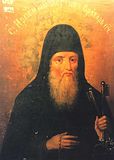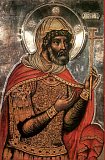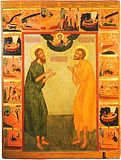

| Previous day | Next day |
| Old Style
October 16
|
Sunday |
New Style
October 29
|
| 21st Sunday after Pentecost. Tone 4. | No fast.
|
![]() Martyr Longinus the Centurion, who stood at the Cross of the Lord (1st c.).
Martyr Longinus the Centurion, who stood at the Cross of the Lord (1st c.).
St. Longinus the Gate-keeper, of the Kiev Caves (13th c.-14th c.). Sts. John and Longinus of Yarenga, monks of Solovki (1561). St. Eupraxia, abbess, in the world Princess Euphrosyne, of Pskov (1243). St. Domna, fool-for-Christ, of Tomsk (1872).
Martyrs Isaurus and Aphrodisius, who suffered with St. Longinus (1st c.). St. Gall, monk of Bangor Monastery and enlightener of Switzerland (ca. 646).
Repose of Patriarch Adrian of Moscow (1700) and Abbot Neonil of Neamts, Romania (1853).
Thoughts for Each Day of the Year
According to the Daily Church Readings from the Word of God
By St. Theophan the Recluse

The Twenty-First Sunday After Pentecost. [Gal. 2:16-20; Luke 8:5-15]
The thorns and thistles which choke the word of Divine truth, in addition to being riches, pleasures and cares of this life, at the current time must also be understood to be various false teachings, spread by scholars who have lost the truth and have been knocked off the path to it. Among us such theories differ much: some publicly and openly go against the truth; others do so by oblique hints that are nevertheless understood by those toward whom they are directed. In essence they act like carbon monoxide poisoning—they enter unnoticeably, and cloud the head, leading to a loss of clear consciousness of everything around. He who gets this carbon monoxide poisoning begins to rave like one who is asleep, for everything already appears to him entirely not as it is, not as it appears to one who is in his right mind. When you meet such a person you see that not only is all truth is suppressed in him, but any feeling for the truth is also stifled, and a lie has penetrated all the components of his mind. How should one be? Do not listen to these ravings or read them; and when they are unwillingly heard or read, throw them out of your head. When they are not thrown out—submit them to reason, and they all will scatter like smoke.
Articles
 Martyr Longinus the Centurion, who stood at the Cross of the LordThe Holy Martyr Longinus the Centurion, a Roman soldier, served in Judea under the command of the Governor, Pontius Pilate. |
 Venerable Longinus the Gatekeeper of the Kiev CavesSaint Longinus, the Gate-Keeper of the Kiev Caves, Far Caves, made his monastic obedience at the Kiev Caves monastery. |


